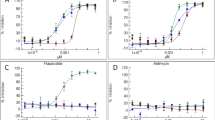Abstract
In 2011, a new Fusarium wilt of Papaver nudicaule was observed in a commercial nursery near Ventimiglia (Imperia province, northern Italy) as well as in the Regional Institute of Floriculture (I.R.F.) of Sanremo (Imperia province, northern Italy). Molecular analysis enabled identification of the causal agent as a new forma specialis called Fusarium oxysporum f. sp. papaveris. The origin of the infection was found on P. nudicaule seeds. However, disinfection with sodium hypochlorite was able to eliminate the pathogen infection. Virulence of ten isolates obtained from seeds was evaluated by pathogenicity assay. The more virulent strains were analyzed by phylogenetic analysis on the basis of the EF-1α, pg1 and pgx4 genes. Sequences obtained by PCR amplification were aligned with other formae speciales of Fusarium oxysporum from the GenBank and used in the construction of the phylogenetic trees. Seed infections have been observed in the case of many vegetable crops; however, this phenomenon has been less studied in the case of ornamental crops. As a consequence of seed exchanges or transmission via infected seeds, new and old pathogenic species of Fusarium are continuously introduced into new areas and production systems.



Similar content being viewed by others
References
Bennett, R. S., Hutmacher, R. B., & Davis, R. M. (2008). Seed transmission of Fusarium oxysporum f. sp. vasinfectum Race 4 in California. The Journal of Cotton Science, 12, 160–164.
Elmer, W. H. (2001). Seeds as vehicles for pathogen importation. Biological Invasions, 3, 263–271.
Elmer, W. H. (2012). Biology and epidemiology. In M. L. Gullino, J. Katan, & A. Garibaldi (Eds.), Fusarium wilts of greenhouse vegetable and ornamental crops (pp. 11–19). St. Paul, MN, USA: APS Press.
Garibaldi, A., Gilardi, G., & Gullino, M. L. (2004). Seed transmission of Fusarium oxysporum f.sp. lactucae. Phytoparasitica, 32, 61–68.
Garibaldi, A., & Gullino, M. L. (2010). Emerging soilborne diseases of horticultural crops and new trends in their management. Acta Horticulturae, 883, 37–46.
Garibaldi, A., Martini, P., Repetto, L., Odasso, M., Bertetti, D., Poli, A., et al. (2012). First report of Fusarium oxysporum causing wilt on Iceland poppy (Papaver nudicaule) in Italy. Plant Disease, 96, 1823.
Gullino, M. L., Katan, J., & Garibaldi, A. (2012). The genus Fusarium and the species that affect greenhouse vegetables and ornamentals. In M. L. Gullino, J. Katan, & A. Garibaldi (Eds.), Fusarium wilts of greenhouse vegetable and ornamental crops (pp. 9–11). St. Paul, MN, USA: APS Press.
Hirano, Y., & Arie, T. (2009). Variation and phylogeny of Fusarium oxysporum isolates based on nucleotide sequences of polygalacturonase genes. Microbes and Environments, 24, 113–120.
Jenkins, S. F. (1983). Occurrence of Fusarium oxysporum f. sp. cucumerinum on greenhouse-grown Cucumis sativus seed stock in North Carolina. Plant Disease, 67, 1024–1025.
Komada, H. (1975). Development of a selective medium for quantitative isolation of Fusarium oxysporum from natural soil. Review of Plant Protection Research, 8, 114–125.
Leslie, J. F., & Summerell, B. A. (2006). The Fusarium laboratory manual. Ames, IA, USA: Blackwell Professional.
Matheron, M., & Gullino, M. L. (2012). Fusarium wilt of lettuce and other salad crops. In M. L. Gullino, J. Katan, & A. Garibaldi (Eds.), Fusarium wilts of greenhouse vegetable and ornamental crops (pp. 175–183). St. Paul, MN, USA: APS Press.
McGee, D. C. (1995). Epidemiological approach to disease management through seed technology. Annual Review of Phytopathology, 33, 445–466.
O’Donnell, K., Kistler, H. C., Cigelnik, E., & Ploetz, R. C. (1998). Multiple evolutionary origin of the fungus causing Panama disease of banana; concordant evidence from nuclear and mitochondrial gene genealogies. Proceedings of the National Academy of Sciences of the USA, 95, 2044–2049.
Tamura, K., Dudley, J., Nei, M., & Kumar, S. (2007). MEGA4: Molecular Evolutionary Genetics Analysis (MEGA) software version 4.0. Molecular Biology and Evolution, 24, 1596–1599.
Vannacci, G., Cristani, C., Forti, M., Kontoudakis, G., & Gambogi, P. (1999). Seed transmission of Fusarium oxysporum f.sp. basilici in sweet basil. Journal of Plant Pathology, 81, 47–53.
Acknowledgments
The research leading to these results has received funding from the European Union Seventh Framework Programme (FP7/2007-2013) under grant agreement n° 311875.
Author information
Authors and Affiliations
Corresponding author
Rights and permissions
About this article
Cite this article
Bertetti, D., Ortu, G., Gullino, M.L. et al. Contamination of seeds of Iceland poppy (Papaver nudicaule L.) by Fusarium oxysporum . Phytoparasitica 43, 189–196 (2015). https://doi.org/10.1007/s12600-014-0431-4
Received:
Accepted:
Published:
Issue Date:
DOI: https://doi.org/10.1007/s12600-014-0431-4




